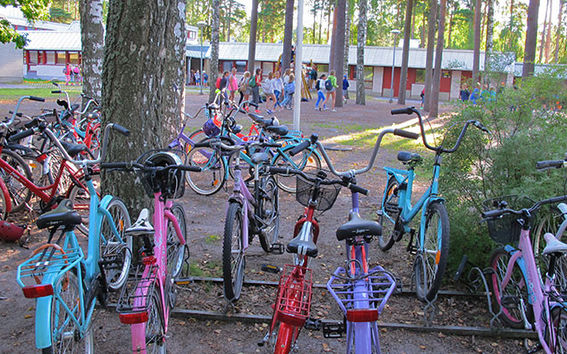Good urban planning supports children's mobility

According to this study, obesity among the Finnish youth has tripled in thirty years. The decreased level of physical activity is considered to be a factor contributing to obesity. Across the western world, children are getting around by foot or by bike independently and without guidance or help from their parents less than before.
'Finnish children do structured exercise more than previously, but the amount of unstructured exercise during free-time, and walking as well as cycling to get around has decreased,' states Anne Broberg, Master of Science.
According to Broberg, more attention than before should be paid to young people's spontaneous mobility. Giving children a lift everywhere undermines their health and well-being.
The right distance
Broberg defended her dissertation on 'The multiple settings of children’s active transportation and independent mobility' at Aalto University. In her dissertation she examines the structural features of society that enable independent mobility of the youth.
The study looks at the mobility of children in their fifth school year and young people in their seventh and eighth school years in the metropolitan area and Turku.
According to the study, the distance is the most decisive factor in choosing the type of transport. Children like to walk to school when the distance is around one kilometre, and three kilometres can easily be managed by bike. The longer the journey, the less enthusiastic they become.
A reasonably compact environment supports independent and active mobility. If the urban environment is very compact, it is easy to turn to public transport. Having to cross busy arterial roads on the way decreases spontaneous, independent mobility.
For example, in the central Helsinki region, the level of children's spontaneous and independent mobility is relatively low. The city centre provides, however, diverse possibilities for children to experience and do things.
The Jumbo shopping centre in Vantaa next to the Kehä III ring road is an example of a built area to which very few come by foot or by bike. People from near and far drive there to do shopping.
Turku is a structurally diverse city, in which the central city region soon changes into suburban neighbourhoods and rural environment.
'Many of the Turku suburbs support independent mobility. Naturally, the longer the journey to the city centre is, the keener people are to use public transport or their own cars to get there,' Broberg says.
Hanging around is also being mobile
According to Broberg, we should see the entire city as a setting that encourages mobility and physical activity instead of merely designing specific playgrounds, sports halls and sports grounds intended for children and the youth. Attention should be paid to places that children and young people find meaningful.
'Hanging around and meeting friends is really important to young people. Urban planning could pay more attention to how young people behave, and reflect on whether things that encourage mobility and physical activity could be generated to settings favoured by young people.'
Urban planning is, however, just one of many factors that affect children's and young people's activity and mobility. Also, the attitudes adults have can be crucial.
'If parents want to support their children's activity and mobility, they should have a positive attitude to young people's tendency to congregate and not see it as a burden,' says Broberg.
In a questionnaire within the dissertation, children gave the highest grade to a place where it was possible to spend time undisturbed. According to Broberg, the result conveys a message that we adults should reflect on.
'Do the respondents long for freedom from timetables, from interaction with others or, for example, for freedom to fulfil themselves?' Broberg asks.
In her study, Broberg used the softGIS method, in which children and young people get to talk about their school journey and places meaningful to them through the internet. The method enables asking additional questions and directing the study delicately to different settings.
Anna Broberg, M.Sc defended her dissertation on 'The multiple settings of children's active transportation and independent mobility' on 7 August 2015 at 12.00 at the Aalto University Department of Real Estate, Planning and Geoinformatics. The title of the dissertation in English is They’ll never walk alone? The multiple settings of children’s active transportation and independent mobility.
The dissertation is available online at: https://aaltodoc.aalto.fi/handle/123456789/17246
Contact information for the doctoral candidate: Anna Broberg, tel. +358 50 538 8809, anna.broberg@aalto.fi
Read more news
Growing Materials, Growing Ideas: Inside the Biomaker Studio
At Aalto University’s Biomaker Studio, initiated by Ena Naito, students and researchers experiment with living materials, from algae to mycelium, creating an open, interdisciplinary space where design, biology, and collaboration grow together.
Your voice gives away valuable personal information, so how do you keep that data safe?
With speech technologies becoming increasingly common, researchers want to make sure we don’t give away more information than we mean to.
Aalto in 2025: Quantum leaps, creative breakthroughs and solutions for a better life
Growth, technology and industrial renewal; human-centred solutions; health and everyday wellbeing; and enjoyable daily life and thriving communities.






